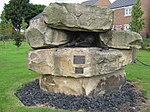Netpark
NETPark or North East Technology Park is a science park in Sedgefield, County Durham, England. The County Durham science park is on the site of the former Winterton Hospital and is home to over 40 companies, employing over 600 people. Sectors include advanced materials and manufacturing, nanotechnology, X-Ray technology, semiconductors, defence, electronics, photonics, robotics, pharmaceutical and space and satellite technology. Since its inception in 2000, NETPark has developed a number of facilities including the NETPark Plexus, NETPark Discovery 1 & 2 and NETPark Explorer buildings totalling over 127,000 sq ft of space. In 2021 Durham County Council approved a £50m investment to fund an additional 270,000 sq ft of space over the next five years. NETPark is owned by Durham County Council and managed by Business Durham. NETPark is the only UK Science Park with two National Catapult Centres CPI's High Value Manufacturing Catapult and North East Centre of Excellence for Satellite Applications. NETPark is home to three national innovation centres all managed by Centre for Process Innovation including National Printable Electronics Centre, National Formulations Centre and National Centre for Healthcare Photonics. Durham University is also part of the science park, through Orbit, the new University Enterprise Zone and The Centre for Advanced Instrumentation, which was the first building to be constructed on the site in 2004.
Excerpt from the Wikipedia article Netpark (License: CC BY-SA 3.0, Authors).Netpark
Joseph Swan Road,
Geographical coordinates (GPS) Address Nearby Places Show on map
Geographical coordinates (GPS)
| Latitude | Longitude |
|---|---|
| N 54.6704 ° | E -1.4501 ° |
Address
NetPark Research Institute
Joseph Swan Road
TS21 3FD
England, United Kingdom
Open on Google Maps




